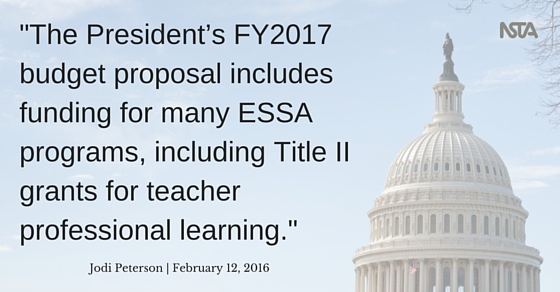President Obama Releases FY2017 Budget
By Jodi Peterson
Posted on 2016-02-12
President Obama released the Administration’s FY2017 budget request this week, including mandatory spending of $4 billion for the opportunity to “give every student from preschool to high school the opportunity to learn hands-on computer science (CS).”
The President’s budget provides $69.4 billion in discretionary funding for the Department of Education, a 2 percent increase over the 2016 appropriation. The budget also includes $139.7 billion in new mandatory funding over the next decade. (Mandatory funding—not a popular concept with CH Republicans who want to shrink the government – requires that additional funding for proposed programs would be offset through revenue enhancements such as taxes, fees, cost reductions, and other levies proposed elsewhere in the budget.)
In addition to the proposed $4 billion in mandatory funds, the new Computer Science for All program would support provide $100 million in discretionary grants for a competitive state initiative to fund innovative strategies to provide high-quality instruction and other learning opportunities in computer science.
Funding Requests for Programs Authorized Under Every Student Succeeds Act (ESSA)
The request for Title I grants was $15.4 billion, an increase of $450 million above the enacted level. Many education advocates publicly worried that this amount would provide less funding for school improvement, however, since the new federal education law, the Every Student Succeeds Act (ESSA) requires states to set aside a portion of Title I funding for school improvement.
The request for ESSA Title II (Preparing, Training, and Recruiting High Quality Teachers and Principals Grants) is $2.25 billion. This major state formula grants program provides funds to each state to increase student achievement and close achievement gaps and to improve the effectiveness of teachers and school leaders. Funding for STEM education and educators is available under this grant.
The president requested $500 million for the new ESSA Title IV Part A block grant (Student Support and Academic Enrichment Grants, which also provides funding for STEM activities), considerably less than the $1.6 billion authorized in the new federal education law. The president’s budget proposal would allocate these grants to states by formula and then districts would have the option of competing for the funds. ESSA requires that the money would be allocated states and districts by formula.
The Administration requested $10 million in new funding for the national STEM Master Teacher Corps, one of the specific “national activities” authorized under ESSA.
Funding for 2017 was $180 million (up from $60 million to FY2016) for the Education Innovation and Research program, the successor to the Investing in Innovation (i3) program.
21st Century Community Learning Centers funding request was $1.0 billion (a loss of $166.7 million from FY 2016), to support locally-based out-of-school learning and enrichment activities.
In addition to the Computer Science For All program, the President’s budget this year includes requested funding for a number of programs not authorized under the ESSA, including
- A new RESPECT: Best Job in the World program that would make a $1 billion mandatory investment to support a nationwide effort to attract and retain effective teachers in high-need schools.
- $125 million for the proposed Teacher and Principal Pathways program for grants to institutions of higher education and nonprofit organizations to create or expand high-quality pathways into the teaching profession, particularly into high-needs schools and high-need subjects such as science, technology, engineering and math (STEM)
- $10 million for Teach to Lead grantsto build on the promising work at the Department’s “Teach to Lead” gatherings
- $120 million for new “Stronger Together” grants that would help districts implement voluntary, community-developed plans to promote integration.
- $80 million to help launch Next Generation High Schools “that will be laboratories for cutting-edge STEM teaching and learning.” Next Generation High Schools was in the president’s budget proposal last year as well.
National Science Foundation programs
The President’s request for the National Science Foundation would increase NSF’s discretionary spending by about $100 million, to $7.6 billion. The NSF’s Education and Human Resources Directorate funding is proposed at $952.86 million, an increase of $72.86 million or 8.3% over FY 2016. $53.99 million of this proposed increase is in the form of mandatory spending. The request for Advancing Informal Science Learning was $62.5 million (same as FY 2016, $7.5 million of this total would be mandatory funding.); STEM+Computer Science Partnerships Program request was $51.88 million (same as FY 2016, $30.64 million of this amount would be mandatory spending) and the President requested $60.89 million (same as FY 2016) for the Robert Noyce Teacher Scholarships.
Read the WH STEM Fact Sheet.
Jodi Peterson is Assistant Executive Director of Legislative Affairs for the National Science Teachers Association (NSTA) and Chair of the STEM Education Coalition. e-mail Peterson at jpeterson@nsta.org; follow her on Twitter at @stemedadvocate.
The mission of NSTA is to promote excellence and innovation in science teaching and learning for all.
Follow NSTA
Disclaimer: The views expressed in this blog post are those of the author(s) and do not necessarily reflect the official position of the National Science Teaching Association (NSTA).



